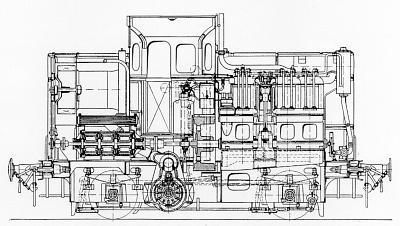| B A L D W I N L O C O M O T I V E S | 47 |
|
|
|
system of multiple clutches worked by oil
pressure and gives four speeds in each direction.
This is one of the best type of Diesel
industrial engine yet constructed for
standard gauge tracks. The most ambitious plan for using mechanical transmission (with a magnetic clutch) is represented by a locomotive of 1100 horse-power which is at present under construction at the Gomsa Works (Germany), for the Russian Government. The locomotive will have five pairs of coupled driving wheels and two carrying trucks, and will weigh 125 metric tons. It is to be put into comparative test with the "Lomonossoff" Diesel-electric locomotive of similar driving-wheel arrangement and capacity. |
The Fiat Works of Turin, Italy, working in
conjunction with the electrical concern
of Brown, Boveri and Company, have constructed
a locomotive of 440 horse-power
for the 3 ft. gauge Colobio-Lucano Railway,
which has gradients up to 6 per cent and
curves of 100 metres radius; a very severe
service for any locomotive. This machine
is carried on two swiveling trucks, both of
which are equipped with electric motors.
The prime mover is a six-cylinder, two-cycle
Diesel engine running at 500 revolutions per
minute. It is started electrically, by
storage battery, exciter and motor-generator. This machine has been in
regular operation since 1924 and is
reported to be generally satisfactory. The Diesel-electric locomotive that has |
|
pressure. Its limitation is probably in the
neighborhood of 500 horse-power, although
its advocates claim adaptability to twice
this figure. The Hele-Shaw and Lentz systems are the best known examples of hydraulic transmission. Electric Transmission.—In this system the prime mover is connected to an electric generator which furnishes current to operate suitably disposed driving motors. Electric transmission gives a continually variable gear, allowing the locomotive to advantageously adapt itself to the speed of the prime mover. It makes driving easy and is readily adaptable to double-end control. The installation is expensive, but from the railway operating viewpoint it is the most attractive transmission. Within recent years quite a few Diesel-electric locomotives have been built in Europe and the United States. A short description of some of these may prove interesting. |
attracted most attention in Europe is the design by Professor Lomonossoff, constructed at Diisseldorf, Germany, for the Russian Government Railways. It is of 2-10-2 wheel arrangement, with five motor-driven axles. It is arranged for double-end control; the driver's cabins being located over the carrying trucks. The engine is a Diesel M. A. N. submarine type, four-cycle, six-cylinder unit, employing compressed air fuel injection. Its normal speed is 450 revolutions per minute; its maximum power, 1200 horse-power. The locomotive unit itself is rated at 1000 horse-power, and to verify this rating the machine was thoroughly tested on a special plant, similar to that of the Pennsylvania Railroad at Altoona. A comparison was made of these with tests of a Russian type 0-10-0 steam locomotive, oil fired. Dr. Herbert Brown, of Winterthur, personally assisted in these tests and reports an average overall thermal efficiency of 7.43 per cent for the steam |
